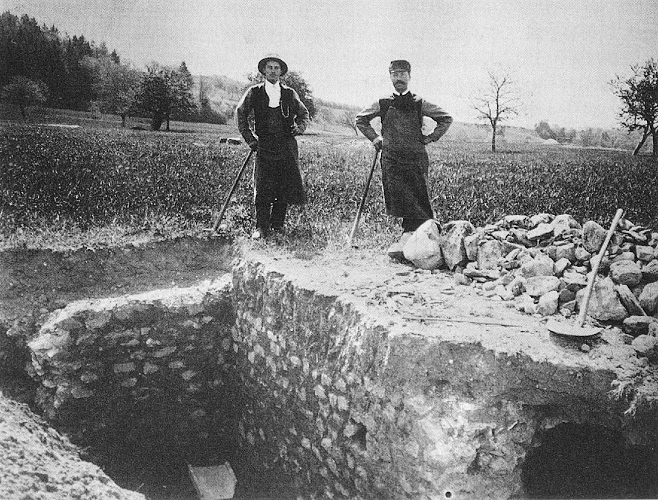To the north of Lausanne, some eight kilometers to the north of the Lac Léman, the remains of a villa were excavated at the locality Le Buy, between the villages of Morrens and Cheseaux-sur-Lausanne. Nearby, at the locality Etagnières, the workshop of a blacksmith was excavated. The ruins were searched and excavated in the last three decades of the 19th century and in 1998. Some information was also provided by aerial photos taken in 1976 and 1989. The construction of the villa started in the middle of the first century. It was enlarged in the second, and given up at the end of the third century.

Left: excavations of the villa in 1891.
Right: limestone column found in the 19th century.
Photos: Reymond et al. 2009, figs. 4-5.The rooms were arranged around a courtyard measuring 30 x 60 m., surrounded by a porticus (D). A structure in the centre of the courtyard might have been a nymphaeum. The descriptions from the 19th century speak of baths with heated rooms, basins, and a large curved wall. These rooms must have been in the eastern part (A). In rooms in the southern part large storage jars (dolia) seem to have been found (B). The ceramics suggest that there was a kitchen here. There were more rooms in the northern part (C, with annex C'). On the western side may have been a potter's workshop: a potter's kiln was mentioned in the 19th century (E). The isolated square structure G (9.50 x 9.50 m.) could have been a Gallo-Roman temple. In the 19th century an aqueduct was also mentioned, bringing water to an underground room, apparently a cistern.
Plan of the investigated part of the villa. Reymond et al. 2009, fig. 20.
Red: 19th century excavations; blue: 1998 excavations; green: suggested walls.
A: rooms; B: south wing; C: north wing; C': annex; D: courtyard; E: potter's workshop (?);
F: continuation towards the west; G: Gallo-Roman temple (?).Two remarkable terracotta vessels were found in the isolated square room that may have been a temple (G). Amongst the metal finds a bronze plate decorated with a fish stands out. Some of the finds point to the presence of cattle, the production of cheese, and work with textile.
Locally produced vessel. H. 0.186. Found in the 19th century.
Depiction of a hunting scene (venatio).
Photo: Reymond et al. 2009, fig. 27.Vessel of terra sigillata. H. 0.25. Found in the 19th century.
Depiction of Hercules and a seated goddess holding a horn of plenty.
Photo: Reymond et al. 2009, fig. 29.
Bronze plate with a depiction of a fish. W. 0.34. Photo: Reymond et al. 2009, fig. 33.During the old excavations fragments of paintings were found and several mosaics. Of the latter only one has been preserved, a polychrome mosaic discovered in 1870 in the eastern part of the complex. Stylistically it has been assigned to the second half of the second century or the early third century.
Mosaic discovered in 1870 (3.35 x 3.03 m.). Photo: Reymond et al. 2009, fig. 37.The workshop of a blacksmith, Identified by the presence of slag, was a small building measuring 10.50 x 11.00 m.
Map with the location of the villa and the workshop of a blacksmith. Reymond et al. 2009, fig. 2.
Blue: 19th century excavations; red: 1998 excavations.
Plan of the workshop. Reymond et al. 2009, fig. 61.
Reconstruction of the workshop. Reymond et al. 2009, fig. 66.
Literature
Cornu 1880; Anzeiger für schweizerische Alterthumskunde 7,25-4 (1892), 154-155; Delessert de Mollins 1893; Mellet 1899; Drack 1950, 64-65; Von Gonzenbach 1961, 92-93; Revue historique vaudoise 90 (1982), 176; Drack-Fellmann 1988, 446; Reymond et al. 2009.
[9-Mar-2024]